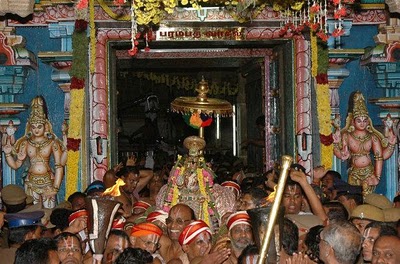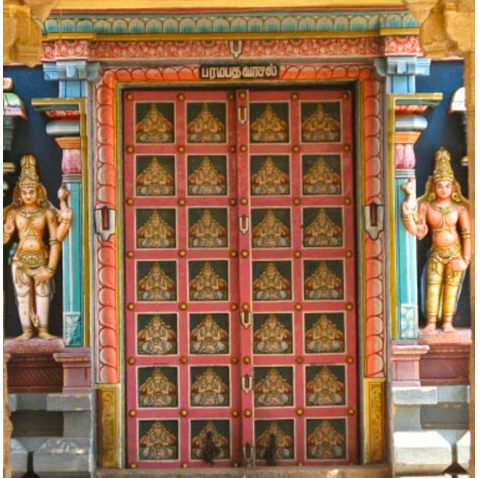Today the 5th of January 2012 is Vaikunta Ekadasi and its grandly celebrated in all Srivaishnava Temples around the world.
The details of the celebrations in Srirangam is as follows:
Irapathu – Era pathu Utsavam at Srirangam
Irapathu – Era Pathu 1st Day – 05.01.2012: VAIKUNTA EKADASI : 3.30 hrs to 24.00 hrs:
Namperumal Moolasthanthil irunthu purapadu (Leaving from Sanctum Sanctorum) @ 3.30 am.; Paramapatha vasal (Sorka vaasal) thiruppu (opening of Sorga vaasal) at 4.30 hrs.
Paramapada vasal @ sorga vaasal will remain open till 22.hrs on 5.1.2012 and from 12.00 noon to 20 hrs everyday for the next 9 days till 14.1.2012.
(Araiyar Sevai: “Uyarvara Uyarnalam” Pasuram – Abhinayam, Vyakhyanam; Thiruvaimozhi muthal pathu (first 10) pasurangal)
Irapathu – Era Pathu 2nd day – 06.01.2012: : 11.00 to 21.30 hrs:
(Araiyar Sevai: “Kilaroliyilamai” Pasuram, Abhinayam, Vyakhyanam; Thiruvaimozhi irandam pathu pasurangal)
Irapathu – Era Pathu 3rd day – 07.01.2012: : 11.00 to 21.30 hrs:
(Araiyar Sevai: “Ozhivil Kalamellam” Pasuram, Abhinayam, Vyakhyanam; Thiruvaimozhi Moondram pathu (third 10 pasurangal)
Irapathu – Era Pathu 4th – 08.01.2012: : 11.00 to 21.30 hrs:
(Araiyar Sevai: “Onrundhevum” Pasuram, Abhinayam, Vyakhyanam; Thiruvaimozhi Nangam pathu pasurangal (fourth 10 pasurangal)
Irapathu – Era Pathu 5th day – 09.01.2012: : 11.00 to 21.30 hrs:
(Araiyar Sevai: “Aaravamuthe” Pasuram, Abhinayam, Vyakhyanam; Thiruvaimozhi aintham pathu pasurangal – 5th 10 pasurangal)
Irapathu – Era Pathu 6th day – 10.01.2012: : 11.00 to 21.30 hrs:
(Araiyar Sevai: “Ulagam Unda Peruvaya” Pasuram, Abhinayam, Vyakhyanam; Thiruvaimozhi Aaram pathu pasurangal – 6th 10 pasurangal)
Irapathu – Era Pathu 7th day – 11.01.2012: Thirukaithala Sevai : 15.15 hrs to 23.30 hrs: (Thirukaithala Sevai – Nammalwar Parangusa Nayakiyana Thirukolathil (Nammalwar in and as Parangusa Nayagi) at 6.00 am)
(Araiyar Sevai: “Kangulum Pagalum ” Pasuram, Abhinayam, Vyakhyanam; Iranya vadham; vyagyanam; Araiyar Theertham; Sri sadagopam sadithal; Thiruvaimozhi Yelam (Yezham) pathu pasurangal)
Irapathu – Era Pathu 8th day – 12.01.2012: Thirumangai Mannan Vedupari : 16.30 hrs to 23.00 hrs: (Thirumangai Mannan Vedupari at 17.30 hrs.
(Araiyar Sevai: “Nedumarkadimai” Pasuram, Abhinayam, Vyakhyanam; Thiruvaimozhi yettam pathu pasurangal)
Irapathu – Era Pathu 9th day – 13.01.2012: : 11.00 to 20.30 hrs:
(Araiyar Sevai: “Maalai Nanneer” Pasuram, Abhinayam, Vyakhyanam; Thiruvaimozhi Onpadham pathu pasurangal – 9th ten pasurangal)
Irapathu – Era Pathu 10h day – 14.01.2012: Theerthavari : 09.00 hrs (14.1.) to 09.30 hrs (15.1) : Theertha Vari at Chandra Pushkarini @ 10.00 hrs.
“Nammalwar Moksham or Nammalwar Motcham” at 06.00 hrs on 15.01.2012.
(Araiyar Sevai: “Thala Thamarai” Pasuram, Abhinayam, Vyakhyanam; Thiruvaimozhi Patham pathu pasurangal (10th and final ten thiruvaimozhi verses; Thiruvaimozhi Satrumurai)
Sankranthi : 15.1.2012
Purapaadhu : Leaving from Sanctum sanctorum : 12.15 hrs. Sankranthi Mandapam Seruthal (reaching Sankranthi Mantap): 13.00 hrs Leaving Sankranthi Mantap at 17.30 hrs.
Significance of Ekadasi Vratham
EkAdasi Vratham is the observance of suddha UpavAsam (total fast ) on Ekaadasi tithi . DvAdasi vratham is the start of the fast on the night of Dasami tithi on both sukla and KrishNa paksham ( waxing and waning moon fortnights ) , observance of the full fast on EkAdasi day and breaking of the fast on DvAdasi day BEFORE the end of the Dvadasi tithi . Ekadasi vratham however does NOT require the breaking of fast before the conclusion of the Dvadasi tithi . Even on Ekadasi Vratham days , the elderly and the children are exempted from fasting .It is also permissible to observe EkAdasi vratham with partaking of fruits and milk for those who can not observe a complete fast .
The day of EkAdasi is to be spent in meditation and DhyAnam of Sriman NaarAyaNA , Aaraadhanam , Japam et al . For those , who are unable to perform all of these , a recitation of VishNu Sahasra Naamam once is recommended .
Breaking of the fast (PaaraNai ) on DvAdasi days is done after feeding first guests , if available . Special food like ahatthi keerai ( a type of broad-leaved spinach ) and Nellikkai pacchadi ( jam of a citrus type of fruit ) have to be taken in first to serve as a restorer of the equalibrium in the stomach after extended fasting. The physological effect of biweekly fasting is terrific on the body.One gives a break to the digestive system and let it rest & recover for two days in a month . People live longer . In the beginning , it may be difficult to observe the fast , but one gets used to it afterwards. If one has low blood sugar or other symptoms , one should moderate the severity of the fasting . Even intake of meals in moderation is recommended for them . Prayers , meditations and reflections on the divine attributes of the Lord are recommended accompaniments to EkAdasi and DvAdasi Vrathams. The day of EkAdasi is to be spent in prayers and japam and , visits to the temple .
In MahA Bharatham , Lord KrishNA answers DuryodhanA’s query on why He did not eat at his palace and instead ate at VidhurA’s house . The Lord explained :
sudhdam BhagavathAsyaannam suddham Bhageerathi jalam I suddham VishNupadha dhyAnam suddham EKAADASI VRATHAM II
(MEANING): The food partaken at a BhakthA’s house is superior and pure . At he same level of holiness are the intake of GangA theertham , VishNu DhyAnam and the observance of EkAdasi vratham . SaasthrAs state that those , who fail to eat on Ekadasi days due to anger , desire (kaamam) or stinginess (lobham ) get the full fruits of the observance of EkAdasi Vratham , even if their intent was not on observing EkAdasi vratham .
The greatness of DvAdasi vratham that incorporates inside it the EkAdasi vratham is illustrated by the story of the king Ambarisha , a predecessor of Sri Ramachandra . He observed DvAdasi Vratham for an year on the banks of the river YamunA . Ambarisha was a great devotee of Sriman NaarAyaNA and a Nishkaama Karmi . BhagavAn’s archanA and Bhagavatha SevA were his goals in life ( KarmaNyEvaadhikArasthE maa palEshu kadAchana ) .
At the conclusion of the year’s observance of DvAdasi vratham , a sage by the name of DurvAsa came to visit AmbarishA on the day of the final paaraNai . The king was happy to have the visit of the well known sage and invited him to be his honored guest before his paaraNai . DurvAsa was known for his habit of flying into rage over any intended or unintended discourtesy to him .
The sage was an observer of EkAdasi vratham , but not DvAdasi vratham . He showed up in the court of king AmabarishA , while there was one and half hour alone left for the completion of the DvAdasi tithi . The sage accepted the invitation for the partaking of the food at the royal household as an athithi (guest ) of the king on that dvAdasi day . He mentioned to the king that he would go to the river to perform his snAnam and rituals and return to the palace for the meals .
DurvAsa muni was not an observer of the DvAdasi vratham .He only observed the EkAdasi vratham and had no sensitivity about completing his meals before the conclusion of the DvAdasi tithi . Hence , he tarried at the river as the clock was ticking away towards the conclusion of the tithi . The king was on pins and needles . On one hand he could not start his paaraNai before feasting DurvasA , his surprise guest ; on the other hand , he will lose the fruits of the obsevance of the whole year’s DvAdasi vratham , if he did not break his fast before the conclusion of the Dvadasi tithi . He consulted his AchAryAs on what to do with respect to this dilemma , while waiting for DurvAsar to return from the river bank .
The assembled Vedic scholars ruled that the king can take a sip of the theertham used in the abolution of the SaaLagrAmams prior to the conclusion of the DvAdasi tithi to fulfill the requirements of the timely pAraNai . This way , he can gain the fruits of the observance of the DvAdasi vratham , while waiting for the return of the Sage DurvAsaa. The king took one spoonful of SaaLagrAma theertham . Minutes after, the sage came back to the palace and flew into a rage, when he learned that the king had broken his fast with sacred water , prior to feeding him .
The angry sage pulled a hair from his matted locks and threw it on ground. A fierce demon came out and began to run towards the king to destroy him . The king did not move. At the same time , the divine Sudarsanam( the powerful Disc resting on the right hand of Sriman NaarAyaNA ) appeared and killed the demon . Next it began to chase the angry DurvAsa . The heat from the Sudarsanam was equivalent to thousands of Suns and DurvAsa ran to escape from it. He ran in all directions and could not escape from the chasing disc of the Lord. He went to BrahmA and appealed for rescue .He was turned down by BrahmA , who acknowledged his powerlessness. Next he went to SivA in KailAsam . Lord SivA admitted that he has no power to stop the powerful Sudarsanam either .
Finally , DurvAsa went to Sri VaikuNtam and prayed to Sriman NArAyaNA to save him from the chasing disc of His. The Lord replied :
aham Bhaktha parAdheena: hyasvatantra iva dhvija I sadhubhi: grastha hrudhaya: bahkthairbhaktha jaanpriya: II
naahamAthmAnam aasAsE madhbhakthai: saadhubhirvinaaI Sriyam chAthyanthakeem brahmanyEshAm gathiraham paraaII
(Meaning ) : O Great Sage ! I am deeply attached to my devotees. Infact , I am controlled by them . Therefore I am incapable of doing anything out of my own volition in such cases involving aparAdham to my devotees . My love for my bhakthAs is greater than that for Myself or My consort , MahA Lakshmi .
SaadhavO hrudhayam mahyam Saadhunaam hrudhyam tvaham I madanyatthE n ajaananthi naaham tEbhyO managapi II
(Meaning ) : My bhakthAs are like my heart to me. I am their hearts. Our understanding of each other is total and complete.
Then , Sriman NaarAyaNA reminded Sage DurvAsA that the Tapas (penance ) and the JnAnam are fruitless as long as there is no modesty /humility (Vinayam ) that accompanies them . Sriman NaarAyaNA suggested that the Sage return to the side of His BhakthA AmbareeshA and seek his forgivance for the ApachAram . Sage DurvAsa ran to the side of AmbarishA as Sudarsanam followed him and fell at the feet of the parama BhakthA of the Lord. The sage returned to the king’s side after an year of runnning hither and thither to escape form the Lord’s disc and to seek relief with the help of Gods . Meanwhile , King AmabarishA was waiting patiently for the return of the Sage to complete his Dvaadasi PaaraNai . The king was taking water only as his intake dutring that whole period of waiting .
AmbarishA saw the fierce Sudarsanam with its flames and sixteen kinds of weapons chasing the Sage rushing towards him . He was awe struck and began to pray to Sudarsana BhagavAn to spare the sage :
Sudarsana namasthubhyam sahasrArAchyutha Priya I sarvAsthraghAthinviprAya svasthibhooyA itaspathE II
(meaning): O BhagavAn Sudarsana with thousand points of flame ! O Sudarsana dear to Sriman NaarAyaNA ! O powerful SudarsanA , who can destroy all kinds of weapons ! My salutaitons to You ! Please confer auspiciousness on Sage DurvAsA and spare him from Your wrath .
The Lord’s Weapon , Sudarsanam acceded to the request of the parama BhakthA and returned to the hand of the Lord. DurvAsA saluted the King and blessed him as well .
That is the legend behind the power of DvAdas/EkAdasi UpavAsam.
Ekadasi description source: Oppiliappan Koil VaradAchAri Sadagopan










